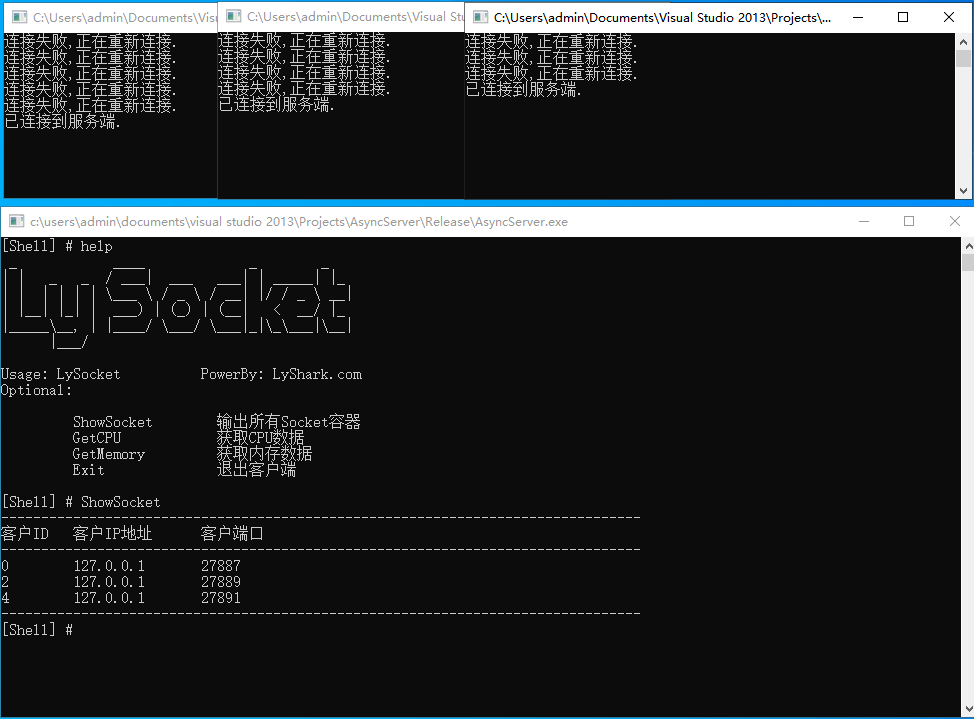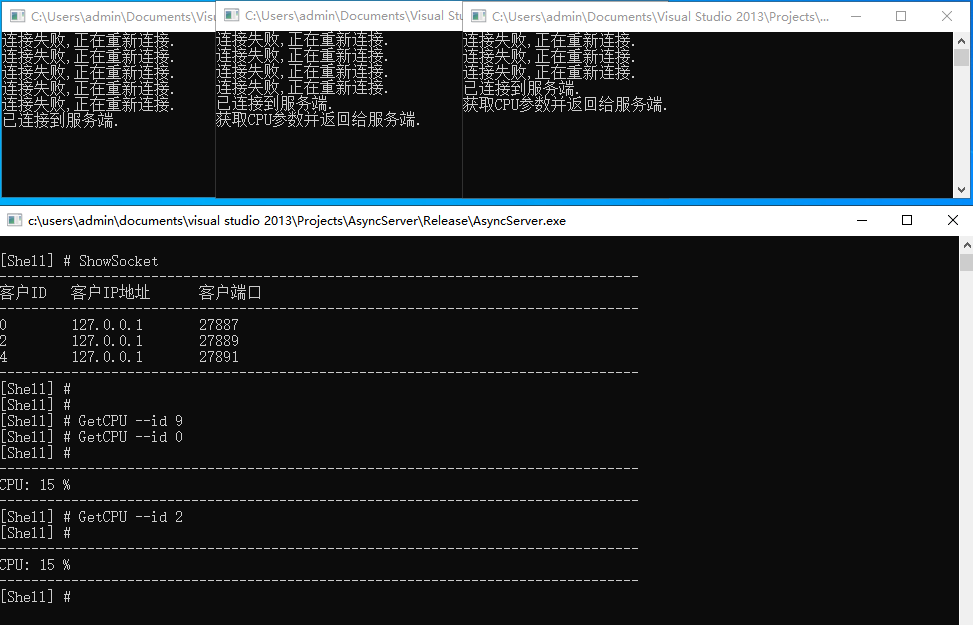C++ ASIO 實現非同步通訊端管理
Boost ASIO(Asynchronous I/O)是一個用於非同步I/O操作的C++庫,該框架提供了一種方便的方式來處理網路通訊、多執行緒程式設計和非同步操作。特別適用於網路應用程式的開發,從基本的網路通訊到複雜的非同步操作,如遠端控制程式、高並行伺服器等都可以使用該框架。該框架的優勢在於其允許處理多個並行連線,而不必建立一個執行緒來管理每個連線。最重要的是ASIO是一個跨平臺庫,可以執行在任何支援C++的平臺下。

本章筆者將介紹如何通過ASIO框架實現一個簡單的非同步網路通訊端應用程式,該程式支援對Socket通訊端的儲存,預設將通訊端放入到一個Map容器內,當需要使用時只需要將通訊端在容器內取出並實現通訊,使用者端下線時則自動從Map容器內移除,通過對本章知識的學習讀者可以很容易的構建一個跨平臺的簡單遠控功能。
AsyncTcpClient 非同步使用者端
如下這段程式碼實現了一個基本的帶有自動心跳檢測的使用者端,它可以通過非同步連線與伺服器進行通訊,並根據不同的命令返回不同的資料。程式碼邏輯較為簡單,但為了保證可靠性和穩定性,實際應用中需要進一步優化、處理錯誤和異常情況,以及增加更多的功能和安全性措施。
首先我們封裝實現AsyncConnect類,該類內主要實現兩個功能,其中aysnc_connect()方法用於實現非同步連線到伺服器端,而port_is_open()方法則用於驗證伺服器特定埠是否開放,如果開放則說明伺服器端還線上,不開放則說明伺服器端離線此處嘗試等待一段時間後再次驗證,在呼叫boost::bind()函數繫結通訊端時通過&AsyncConnect::timer_handle()函數來設定一個超時等待時間。
進入到主函數中,首先程式通過while迴圈讓程式保持持續執行,並通過hander.aysnc_connect(ep, 5000) 每隔5秒驗證是否與伺服器端連線成功,如果連線了則進入內迴圈,在內迴圈中通過hander.port_is_open("127.0.0.1", 10000, 5000)驗證特定埠是否開放,這主要是為了保證伺服器端斷開後用戶端依然能夠跳轉到外部迴圈繼續等待伺服器端上線。而當用戶端與伺服器端建立連線後則會持續在內迴圈中socket.read_some()接收伺服器端傳來的特定命令,以此來執行不同的操作。
#define BOOST_BIND_GLOBAL_PLACEHOLDERS
#include <iostream>
#include <string>
#include <boost/asio.hpp>
#include <boost/bind.hpp>
#include <boost/array.hpp>
#include <boost/date_time/posix_time/posix_time_types.hpp>
#include <boost/noncopyable.hpp>
using namespace std;
using boost::asio::ip::tcp;
// 非同步連線地址與埠
class AsyncConnect
{
public:
AsyncConnect(boost::asio::io_service& ios, tcp::socket &s)
:io_service_(ios), timer_(ios), socket_(s) {}
// 非同步連線
bool aysnc_connect(const tcp::endpoint &ep, int million_seconds)
{
bool connect_success = false;
// 非同步連線,當連線成功後將觸發 connect_handle 函數
socket_.async_connect(ep, boost::bind(&AsyncConnect::connect_handle, this, _1, boost::ref(connect_success)));
// 設定一個定時器 million_seconds
timer_.expires_from_now(boost::posix_time::milliseconds(million_seconds));
bool timeout = false;
// 非同步等待 如果超時則執行 timer_handle
timer_.async_wait(boost::bind(&AsyncConnect::timer_handle, this, _1, boost::ref(timeout)));
do
{
// 等待非同步操作完成
io_service_.run_one();
// 判斷如果timeout沒超時,或者是連線建立了,則不再等待
} while (!timeout && !connect_success);
timer_.cancel();
return connect_success;
}
// 驗證伺服器埠是否開放
bool port_is_open(std::string address, int port, int timeout)
{
try
{
boost::asio::io_service io;
tcp::socket socket(io);
AsyncConnect hander(io, socket);
tcp::endpoint ep(boost::asio::ip::address::from_string(address), port);
if (hander.aysnc_connect(ep, timeout))
{
io.run();
io.reset();
return true;
}
else
{
return false;
}
}
catch (...)
{
return false;
}
}
private:
// 如果連線成功了,則 connect_success = true
void connect_handle(boost::system::error_code ec, bool &connect_success)
{
if (!ec)
{
connect_success = true;
}
}
// 定時器超時timeout = true
void timer_handle(boost::system::error_code ec, bool &timeout)
{
if (!ec)
{
socket_.close();
timeout = true;
}
}
boost::asio::io_service &io_service_;
boost::asio::deadline_timer timer_;
tcp::socket &socket_;
};
int main(int argc, char * argv[])
{
try
{
boost::asio::io_service io;
tcp::socket socket(io);
AsyncConnect hander(io, socket);
boost::system::error_code error;
tcp::endpoint ep(boost::asio::ip::address::from_string("127.0.0.1"), 10000);
// 迴圈驗證是否線上
go_: while (1)
{
// 驗證是否連線成功,並定義超時時間為5秒
if (hander.aysnc_connect(ep, 5000))
{
io.run();
std::cout << "已連線到伺服器端." << std::endl;
// 迴圈接收命令
while (1)
{
// 驗證地址埠是否開放,預設等待5秒
bool is_open = hander.port_is_open("127.0.0.1", 10000, 5000);
// 使用者端接收封包
boost::array<char, 4096> buffer = { 0 };
// 如果線上則繼續執行
if (is_open == true)
{
socket.read_some(boost::asio::buffer(buffer), error);
// 判斷收到的命令是否為GetCPU
if (strncmp(buffer.data(), "GetCPU", strlen("GetCPU")) == 0)
{
std::cout << "獲取CPU引數並返回給伺服器端." << std::endl;
socket.write_some(boost::asio::buffer("CPU: 15 %"));
}
// 判斷收到的命令是否為GetMEM
if (strncmp(buffer.data(), "GetMEM", strlen("GetMEM")) == 0)
{
std::cout << "獲取MEM引數並返回給伺服器端." << std::endl;
socket.write_some(boost::asio::buffer("MEM: 78 %"));
}
// 判斷收到的命令是否為終止程式
if (strncmp(buffer.data(), "Exit", strlen("Exit")) == 0)
{
std::cout << "終止使用者端." << std::endl;
return 0;
}
}
else
{
// 如果連線失敗,則跳轉到等待環節
goto go_;
}
}
}
else
{
std::cout << "連線失敗,正在重新連線." << std::endl;
}
}
}
catch (...)
{
return false;
}
std::system("pause");
return 0;
}
AsyncTcpServer 非同步伺服器端
接著我們來實現非同步TCP伺服器,首先我們需要封裝實現CAsyncTcpServer類,該類使用了多執行緒來支援非同步通訊,每個使用者端連線都會建立一個CTcpConnection類的範例來處理具體的通訊操作,該伺服器類在連線建立、資料傳輸和連線斷開時,都會通過事件處理器來通知相關操作,以支援伺服器端的業務邏輯。其標頭檔案宣告如下所示;
#ifdef _MSC_VER
#define BOOST_BIND_GLOBAL_PLACEHOLDERS
#define _WIN32_WINNT 0x0601
#define _CRT_SECURE_NO_WARNINGS
#endif
#pragma once
#include <thread>
#include <array>
#include <boost\bind.hpp>
#include <boost\noncopyable.hpp>
#include <boost\asio.hpp>
#include <boost\asio\placeholders.hpp>
using namespace boost::asio;
using namespace boost::asio::ip;
using namespace boost::placeholders;
using namespace std;
// 每一個通訊端連線,都自動對應一個Tcp使用者端連線
class CTcpConnection
{
public:
CTcpConnection(io_service& ios, int clientId) : m_socket(ios), m_clientId(clientId){}
~CTcpConnection(){}
int m_clientId;
tcp::socket m_socket;
array<BYTE, 16 * 1024> m_buffer;
};
typedef shared_ptr<CTcpConnection> TcpConnectionPtr;
class CAsyncTcpServer
{
public:
class IEventHandler
{
public:
IEventHandler(){}
virtual ~IEventHandler(){}
virtual void ClientConnected(int clientId) = 0;
virtual void ClientDisconnect(int clientId) = 0;
virtual void ReceiveData(int clientId, const BYTE* data, size_t length) = 0;
};
public:
CAsyncTcpServer(int maxClientNumber, int port);
~CAsyncTcpServer();
void AddEventHandler(IEventHandler* pHandler){ m_EventHandlers.push_back(pHandler); }
void Send(int clientId, const BYTE* data, size_t length);
string GetRemoteAddress(int clientId);
string GetRemotePort(int clientId);
private:
void bind_hand_read(CTcpConnection* client);
void handle_accept(const boost::system::error_code& error);
void handle_read(CTcpConnection* client, const boost::system::error_code& error, size_t bytes_transferred);
private:
thread m_thread;
io_service m_ioservice;
io_service::work m_work;
tcp::acceptor m_acceptor;
int m_maxClientNumber;
int m_clientId;
TcpConnectionPtr m_nextClient;
map<int, TcpConnectionPtr> m_clients;
vector<IEventHandler*> m_EventHandlers;
};
接著來實現AsyncTcpServer標頭檔案中的功能函數,此功能函數的實現如果讀者不明白原理可自行將其提交給ChatGPT解析,這裡就不再解釋功能了。
// By: 朱迎春 (基礎改進版)
#include "AsyncTcpServer.h"
// CAsyncTcpServer的實現
CAsyncTcpServer::CAsyncTcpServer(int maxClientNumber, int port)
: m_ioservice()
, m_work(m_ioservice)
, m_acceptor(m_ioservice)
, m_maxClientNumber(maxClientNumber)
, m_clientId(0)
{
m_thread = thread((size_t(io_service::*)())&io_service::run, &m_ioservice);
m_nextClient = make_shared<CTcpConnection>(m_ioservice, m_clientId);
m_clientId++;
tcp::endpoint endpoint(tcp::v4(), port);
m_acceptor.open(endpoint.protocol());
m_acceptor.set_option(tcp::acceptor::reuse_address(true));
m_acceptor.bind(endpoint);
m_acceptor.listen();
// 非同步等待使用者端連線
m_acceptor.async_accept(m_nextClient->m_socket, boost::bind(&CAsyncTcpServer::handle_accept, this, boost::asio::placeholders::error));
}
CAsyncTcpServer::~CAsyncTcpServer()
{
for (map<int, TcpConnectionPtr>::iterator it = m_clients.begin(); it != m_clients.end(); ++it)
{
it->second->m_socket.close();
}
m_ioservice.stop();
m_thread.join();
}
// 根據ID號同步給特定使用者端傳送封包
void CAsyncTcpServer::Send(int clientId, const BYTE* data, size_t length)
{
map<int, TcpConnectionPtr>::iterator it = m_clients.find(clientId);
if (it == m_clients.end())
{
return;
}
it->second->m_socket.write_some(boost::asio::buffer(data, length));
}
// 根據ID號返回使用者端IP地址
string CAsyncTcpServer::GetRemoteAddress(int clientId)
{
map<int, TcpConnectionPtr>::iterator it = m_clients.find(clientId);
if (it == m_clients.end())
{
return "0.0.0.0";
}
std::string remote_address = it->second->m_socket.remote_endpoint().address().to_string();
return remote_address;
}
// 根據ID號返回埠號
string CAsyncTcpServer::GetRemotePort(int clientId)
{
map<int, TcpConnectionPtr>::iterator it = m_clients.find(clientId);
char ref[32] = { 0 };
if (it == m_clients.end())
{
return "*";
}
unsigned short remote_port = it->second->m_socket.remote_endpoint().port();
std::string str = _itoa(remote_port, ref, 10);
return str;
}
void CAsyncTcpServer::handle_accept(const boost::system::error_code& error)
{
if (!error)
{
// 判斷連線數目是否達到最大限度
if (m_maxClientNumber > 0 && m_clients.size() >= m_maxClientNumber)
{
m_nextClient->m_socket.close();
}
else
{
// 傳送使用者端連線的訊息
for (int i = 0; i < m_EventHandlers.size(); ++i)
{
m_EventHandlers[i]->ClientConnected(m_nextClient->m_clientId);
}
// 設定非同步接收資料
bind_hand_read(m_nextClient.get());
// 將使用者端連線放到客戶表中
m_clients.insert(make_pair(m_nextClient->m_clientId, m_nextClient));
// 重置下一個使用者端連線
m_nextClient = make_shared<CTcpConnection>(m_ioservice, m_clientId);
m_clientId++;
}
}
// 非同步等待下一個使用者端連線
m_acceptor.async_accept(m_nextClient->m_socket, boost::bind(&CAsyncTcpServer::handle_accept, this, boost::asio::placeholders::error));
}
void CAsyncTcpServer::bind_hand_read(CTcpConnection* client)
{
client->m_socket.async_read_some(boost::asio::buffer(client->m_buffer),
boost::bind(&CAsyncTcpServer::handle_read, this, client, boost::asio::placeholders::error, boost::asio::placeholders::bytes_transferred));
return;
client->m_socket.async_receive(boost::asio::buffer(client->m_buffer),
boost::bind(&CAsyncTcpServer::handle_read, this, client, boost::asio::placeholders::error, boost::asio::placeholders::bytes_transferred));
boost::asio::async_read(client->m_socket, boost::asio::buffer(client->m_buffer),
boost::bind(&CAsyncTcpServer::handle_read, this, client, boost::asio::placeholders::error, boost::asio::placeholders::bytes_transferred));
}
void CAsyncTcpServer::handle_read(CTcpConnection* client, const boost::system::error_code& error, size_t bytes_transferred)
{
if (!error)
{
// 傳送收到資料的資訊
for (int i = 0; i < m_EventHandlers.size(); ++i)
{
m_EventHandlers[i]->ReceiveData(client->m_clientId, client->m_buffer.data(), bytes_transferred);
}
bind_hand_read(client);
}
else
{
// 傳送使用者端離線的訊息
for (int i = 0; i < m_EventHandlers.size(); ++i)
{
m_EventHandlers[i]->ClientDisconnect(client->m_clientId);
}
m_clients.erase(client->m_clientId);
}
}
AsyncTcpServer 類呼叫
伺服器端首先定義CEventHandler類並繼承自CAsyncTcpServer::IEventHandler介面,該類內需要我們實現三個方法,方法ClientConnected用於在使用者端連線時觸發,方法ClientDisconnect則是在登入使用者端離開時觸發,而當用戶端有資料傳送過來時則ReceiveData方法則會被觸發。
方法ClientConnected當被觸發時自動將clientId使用者端Socket通訊端放入到tcp_client_id全域性容器記憶體儲起來,而當ClientDisconnect使用者端退出時,則直接遍歷這個迭代容器,找到序列號並通過tcp_client_id.erase將其剔除;
// 使用者端連線時觸發
virtual void ClientConnected(int clientId)
{
// 將登入使用者端加入到容器中
tcp_client_id.push_back(clientId);
}
// 使用者端退出時觸發
virtual void ClientDisconnect(int clientId)
{
// 將登出的使用者端從容器中移除
vector<int>::iterator item = find(tcp_client_id.begin(), tcp_client_id.end(), clientId);
if (item != tcp_client_id.cend())
tcp_client_id.erase(item);
}
而ReceiveData一旦收到資料,則直接將其列印輸出到螢幕,即可實現使用者端引數接收的目的;
// 使用者端獲取資料
virtual void ReceiveData(int clientId, const BYTE* data, size_t length)
{
std::cout << std::endl;
PrintLine(80);
std::cout << data << std::endl;
PrintLine(80);
std::cout << "[Shell] # ";
}
相對於接收資料而言,傳送資料則是通過同步的方式進行,當我們需要傳送資料時,只需要將資料字串放入到一個BYTE*位元組陣列中,並在呼叫tcpServer.Send時將所需引數,通訊端ID,緩衝區Buf資料,以及長度傳遞即可實現將資料傳送給指定的使用者端;
// 同步傳送資料到指定的執行緒中
void send_message(CAsyncTcpServer& tcpServer, int clientId, std::string message, int message_size)
{
// 獲取長度
BYTE* buf = new BYTE(message_size + 1);
memset(buf, 0, message_size + 1);
for (int i = 0; i < message_size; i++)
{
buf[i] = message.at(i);
}
tcpServer.Send(clientId, buf, message_size);
}
使用者端完整程式碼如下所示,執行使用者端後讀者可自行使用不同的命令來接收引數返回值;
#include "AsyncTcpServer.h"
#include <string>
#include <vector>
#include <iostream>
#include <boost/tokenizer.hpp>
using namespace std;
// 儲存當前使用者端的ID號
std::vector<int> tcp_client_id;
// 輸出特定長度的行
void PrintLine(int line)
{
for (int x = 0; x < line; x++)
{
printf("-");
}
printf("\n");
}
class CEventHandler : public CAsyncTcpServer::IEventHandler
{
public:
// 使用者端連線時觸發
virtual void ClientConnected(int clientId)
{
// 將登入使用者端加入到容器中
tcp_client_id.push_back(clientId);
}
// 使用者端退出時觸發
virtual void ClientDisconnect(int clientId)
{
// 將登出的使用者端從容器中移除
vector<int>::iterator item = find(tcp_client_id.begin(), tcp_client_id.end(), clientId);
if (item != tcp_client_id.cend())
tcp_client_id.erase(item);
}
// 使用者端獲取資料
virtual void ReceiveData(int clientId, const BYTE* data, size_t length)
{
std::cout << std::endl;
PrintLine(80);
std::cout << data << std::endl;
PrintLine(80);
std::cout << "[Shell] # ";
}
};
// 同步傳送資料到指定的執行緒中
void send_message(CAsyncTcpServer& tcpServer, int clientId, std::string message, int message_size)
{
// 獲取長度
BYTE* buf = new BYTE(message_size + 1);
memset(buf, 0, message_size + 1);
for (int i = 0; i < message_size; i++)
{
buf[i] = message.at(i);
}
tcpServer.Send(clientId, buf, message_size);
}
int main(int argc, char* argv[])
{
CAsyncTcpServer tcpServer(10, 10000);
CEventHandler eventHandler;
tcpServer.AddEventHandler(&eventHandler);
std::string command;
while (1)
{
std::cout << "[Shell] # ";
std::getline(std::cin, command);
if (command.length() == 0)
{
continue;
}
else if (command == "help")
{
printf(" _ ____ _ _ \n");
printf("| | _ _ / ___| ___ ___| | _____| |_ \n");
printf("| | | | | | \\___ \\ / _ \\ / __| |/ / _ \\ __| \n");
printf("| |__| |_| | ___) | (_) | (__| < __/ |_ \n");
printf("|_____\\__, | |____/ \\___/ \\___|_|\\_\\___|\\__| \n");
printf(" |___/ \n\n");
printf("Usage: LySocket \t PowerBy: LyShark.com \n");
printf("Optional: \n\n");
printf("\t ShowSocket 輸出所有Socket容器 \n");
printf("\t GetCPU 獲取CPU資料 \n");
printf("\t GetMemory 獲取記憶體資料 \n");
printf("\t Exit 退出使用者端 \n\n");
}
else
{
// 定義分詞器: 定義分割符號為[逗號,空格]
boost::char_separator<char> sep(", --");
typedef boost::tokenizer<boost::char_separator<char>> CustonTokenizer;
CustonTokenizer tok(command, sep);
// 將分詞結果放入vector連結串列
std::vector<std::string> vecSegTag;
for (CustonTokenizer::iterator beg = tok.begin(); beg != tok.end(); ++beg)
{
vecSegTag.push_back(*beg);
}
// 解析 [shell] # ShowSocket
if (vecSegTag.size() == 1 && vecSegTag[0] == "ShowSocket")
{
PrintLine(80);
printf("客戶ID \t 客戶IP地址 \t 使用者埠 \n");
PrintLine(80);
for (int x = 0; x < tcp_client_id.size(); x++)
{
std::cout << tcp_client_id[x] << " \t "
<< tcpServer.GetRemoteAddress(tcp_client_id[x]) << " \t "
<< tcpServer.GetRemotePort(tcp_client_id[x]) << std::endl;
}
PrintLine(80);
}
// 解析 [shell] # GetCPU --id 100
if (vecSegTag.size() == 3 && vecSegTag[0] == "GetCPU")
{
char *id = (char *)vecSegTag[2].c_str();
send_message(tcpServer, atoi(id), "GetCPU", strlen("GetCPU"));
}
// 解析 [shell] # GetMemory --id 100
if (vecSegTag.size() == 3 && vecSegTag[0] == "GetMemory")
{
char* id = (char*)vecSegTag[2].c_str();
send_message(tcpServer, atoi(id), "GetMEM", strlen("GetMEM"));
}
// 解析 [shell] # Exit --id 100
if (vecSegTag.size() == 3 && vecSegTag[0] == "Exit")
{
char* id = (char*)vecSegTag[2].c_str();
send_message(tcpServer, atoi(id), "Exit", strlen("Exit"));
}
}
}
return 0;
}
案例演示
首先執行伺服器端程式,接著執行多個使用者端,即可實現自動上線;

當用戶需要通訊時,只需要指定id序號到指定的Socket通訊端編號即可;

本文作者: 王瑞
本文連結: https://www.lyshark.com/post/d0805aed.html
版權宣告: 本部落格所有文章除特別宣告外,均採用 BY-NC-SA 許可協定。轉載請註明出處!